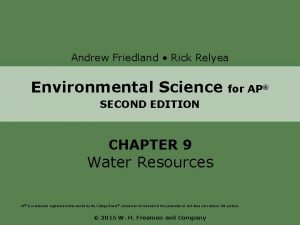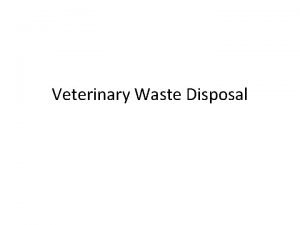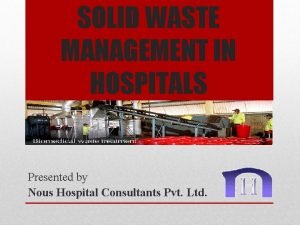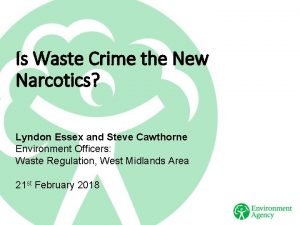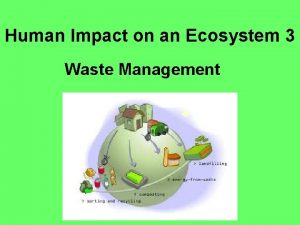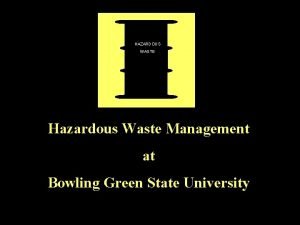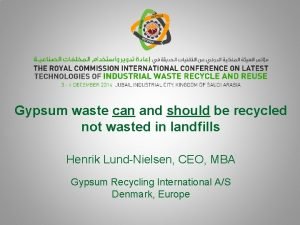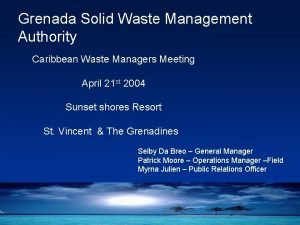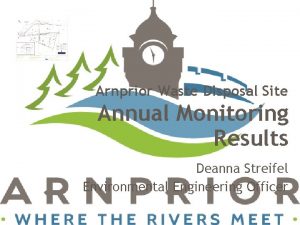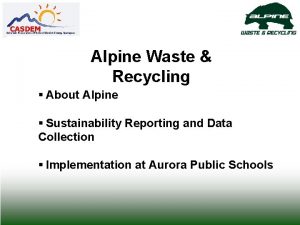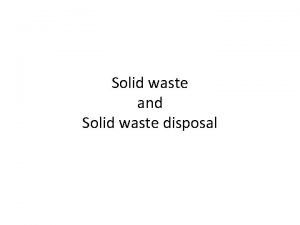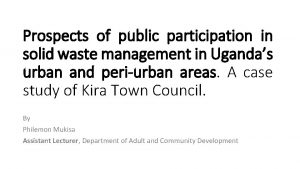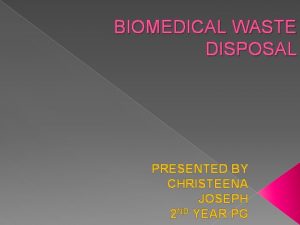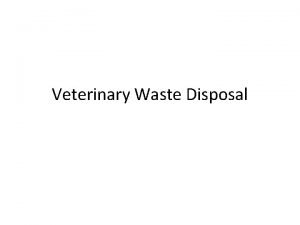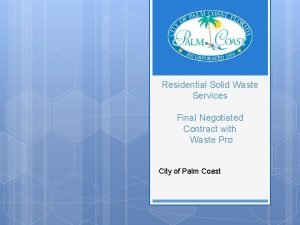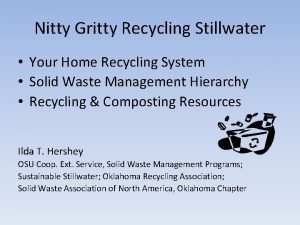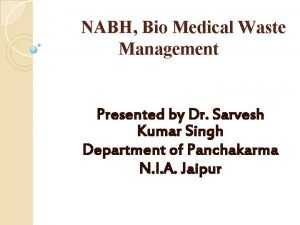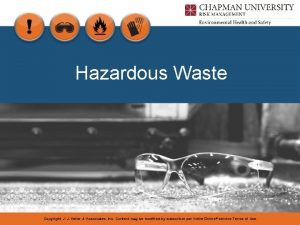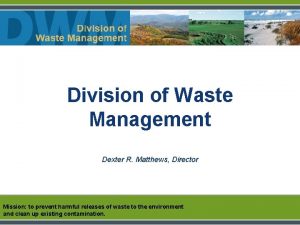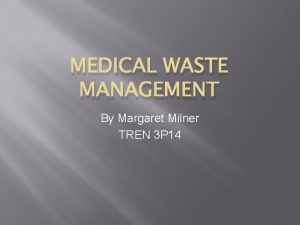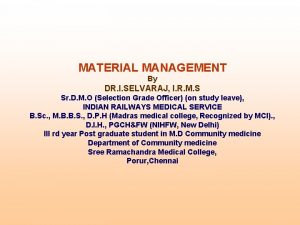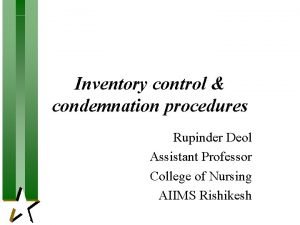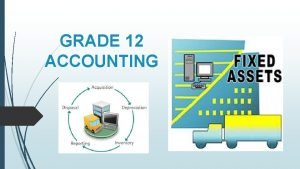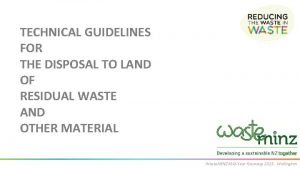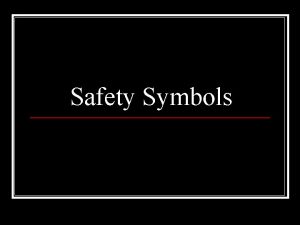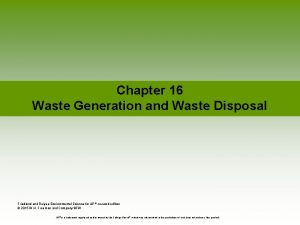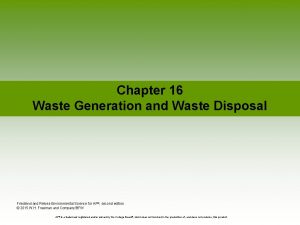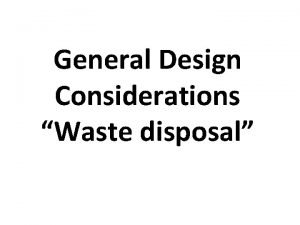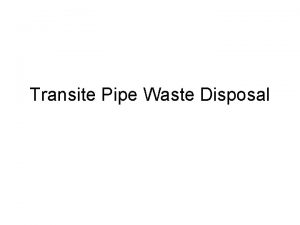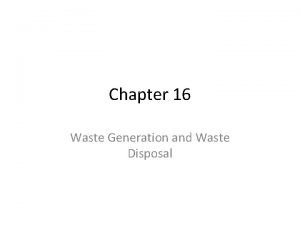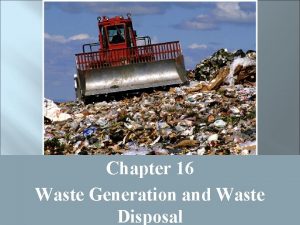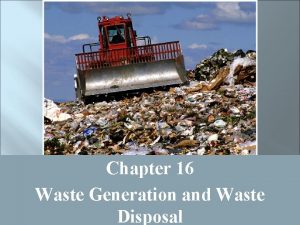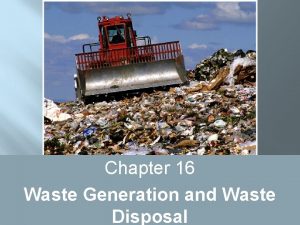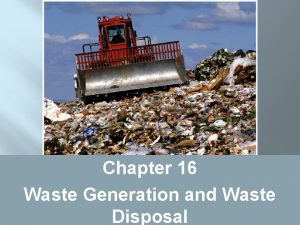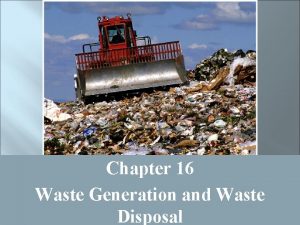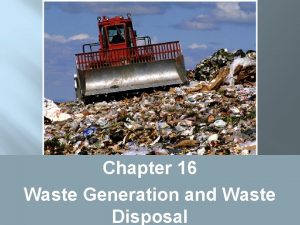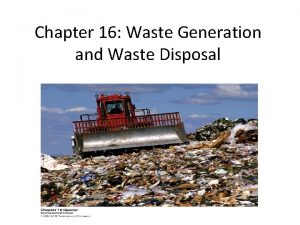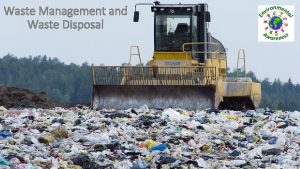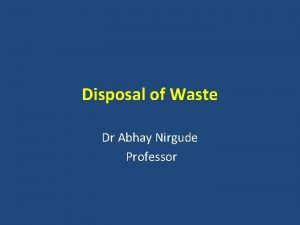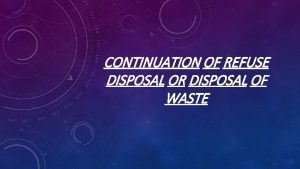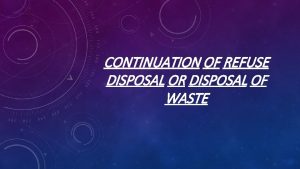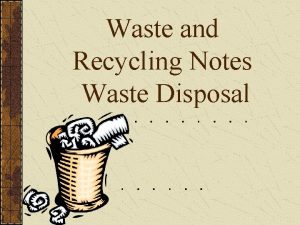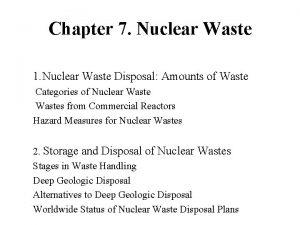Chapter 16 Waste Generation and Waste Disposal Friedland


































- Slides: 34

Chapter 16 Waste Generation and Waste Disposal Friedland Relyea Environmental Science for AP®, second edition © 2015 W. H. Freeman and Company/BFW AP® is a trademark registered and/or owned by the College Board®, which was not involved in the production of, and does not endorse, this product.

Module 51 Only Humans Generate Waste After reading this module, you should be able to • explain why we generate waste and describe recent waste disposal trends. • describe the content of the solid waste stream in the United States.

Humans generate waste that other organisms cannot use • Waste Material outputs from a system that are not useful or consumed. • Municipal solid waste (MSW) Refuse collected by municipalities from households, small businesses, and institutions. • Waste can be viewed as a system.

Waste as a System The solid waste system. Waste is a component of a human-dominated system in which products are manufactured, used, and eventually disposed of (arrows are not proportional). At least some of the waste of this system may become the input of another system.

The Throw-Away Society Municipal solid waste generation in the United States, 1960– 2011. Total MSW generation and per capita MSW generation had been increasing from 1960

The solid waste stream contains materials from many sources • Waste stream The flow of solid waste that is recycled, incinerated, placed in a solid waste landfill, or disposed of in another way.

Composition of Municipal Solid Waste Composition and sources of municipal solid waste (MSW) in the United States. (a) The composition, by weight, of MSW in the United States in 2011 before recycling. Paper, food, and yard waste make up more than half of the MSW by weight. (b) The breakdown of the material that is recovered and the material that is discarded. Paper makes up more than half of the material that is recovered. Food and yard waste make up almost onethird of material that is discarded.

E-Waste • Electronic waste, including televisions, computers, portable music players, and cell phones accounts for roughly 2 percent of the waste stream but its effect is greater than this amount indicates. • E-waste contains toxic metals such as mercury and cadmium which can leach out of landfills. • Even when e-waste is sent to be recycled, it is not always done so properly.

Module 52 The Three Rs and Composting After reading this module, you should be able to • describe three Rs. • understand the process and benefits of composting.

The three Rs divert materials from the waste stream • Reduce, reuse, recycle A popular phrase promoting the idea of diverting materials from the waste stream. Also known as the three Rs.

Reduce • Reduce is the first choice among the three Rs because reducing inputs is the optimal way to achieve a reduction in solid waste generation. • Source reduction An approach to waste management that seeks to cut waste by reducing the use of potential waste materials in the early stages of design and manufacture. • Source reduction can also increase energy efficiency; manufacturing produces less waste and can minimize disposal processes. • Source reduction may also involve substituting less toxic materials or products.

Reuse • Reuse Using a product or material that was intended to be discarded. • Optimally, no additional energy or resources are needed for the object to be reused. • Energy may be required to prepare or transport an object for reuse by someone other than the original user.

Recycle • Recycling The process by which materials destined to become municipal solid waste (MSW) are collected and converted into raw material that is then used to produce new objects. • Closed-loop recycling Recycling a product into the same product. • Open-loop recycling Recycling one product into a different product.

Recycle Closed- and open-loop recycling. (a) In closed-loop recycling, a discarded carpet can be recycled into a new carpet, although some additional energy and raw material are needed. (b) In open-loop recycling, a material such as a beverage container is used once and then recycled into something else, such as a fleece jacket.

Recycle Total weight of municipal solid waste recycled and percent of MSW recycled in the United States over time. Both the total weight of MSW that is recycled and the percentage of MSW that is recycled have increased over time.

Composting is becoming more popular • Organic materials such as food and yard waste that end up in landfills are unstable; the absence of oxygen in landfills causes organic material to decompose anaerobically, which produces methane gas. • Composting Creation of organic matter (humus) by decomposition under controlled conditions to produce an organic-rich material that enhances soil structure, cation exchange capacity, and fertility. • Materials suitable for compositing include vegetables and vegetable by-products, animal manure, yard wastes, and paper fiber not destined for recycling.

Composting A municipal composting facility. A typical facility collects almost 100, 000 metric tons of food scraps and paper year and turns it into usable compost. Most facilities have some kind of mechanized system to allow mixing and aeration of the organic material, which speeds conversion to compost.

Module 53 Landfills and Incineration After reading this module, you should be able to • describe the goals and function of a solid waste landfill. • explain the design and purpose of a solid waste incinerator.

Landfills are the primary destination for MSW The fate of municipal solid waste in the United States. The majority of MSW is disposed of in landfills.

Landfill Basics • Leachate Liquid that contains elevated levels of pollutants as a result of having passed through municipal solid waste (MSW) or contaminated soil. • Sanitary landfill An engineered ground facility designed to hold municipal solid waste (MSW) with as little contamination of the surrounding environment as possible. • Tipping fee A fee charged for disposing of material in a landfill or incinerator.

Landfill Basics A modern sanitary landfill. A landfill constructed today has many features to keep components of the solid waste from entering the soil, water table, or nearby streams. Some of the most important environmental features are the clay liner, the leachate collection system, the cap—which prevents additional water from entering the landfill— and, if present, the methane extraction system.

Choosing a Site for a Sanitary Landfill • Siting The designation of a landfill location, typically through a regulatory process involving studies, written reports, and public hearings. • Landfill siting has been the source of considerable environmental injustice. People with financial resources or political influence often adopt a “not-inmy-backyard, ” or NIMBY, attitude about landfill sites. • A site may be chosen not because it meets the safety criteria better than other options but because its neighbors lack the resources to mount an effective opposition.

Environmental Consequences of Landfills • No matter how careful the design and engineering, there is always the possibility that leachate from a landfill will contaminate underlying and adjacent waterways. • The EPA estimates that virtually all landfills in the United States have had some leaching. • Even after a landfill is closed, the potential to harm adjacent waterways remains. • Anaerobic decomposition generates methane and carbon dioxide—both greenhouse gases—as well as other gaseous compounds. The methane also creates an explosion hazard.

Incineration is another way to treat waste materials • Incineration The process of burning waste materials to reduce volume and mass, sometimes to generate electricity or heat. • Ash The residual nonorganic material that does not combust during incineration. • Bottom ash Residue collected at the bottom of the combustion chamber in a furnace. • Fly ash The residue collected from the chimney or exhaust pipe of a furnace. • Waste-to-energy A system in which heat generated by incineration is used as an energy source rather than released into the atmosphere.

Incineration Basics A municipal mass-burn waste-to-energy incinerator. In this plant, MSW is combusted and the exhaust is filtered. Remaining ash is disposed of in a landfill. The resulting heat energy is used to make steam, which turns a generator that generates electricity in the same manner as was illustrated in Figure 34. 7.

Environmental Consequences of Incineration • Tipping fees are higher at incinerators than at landfills. • An incinerator may release air pollutants from the incomplete combustion of plastics and metals. • Incinerators produce ash that is more concentrated and more toxic than the original MSW. • Incinerator ash that is deemed toxic must be disposed of in a special landfill for toxic materials.

Module 54 Hazardous Waste After reading this module, you should be able to • define hazardous waste and discuss the issues involved in handling it. • describe regulations and legislation regarding hazardous waste.

Hazardous waste requires proper handling and disposal • Hazardous waste Liquid, solid, gaseous, or sludge waste material that is harmful to humans or ecosystems. • Collection sites for hazardous waste must be staffed with specially trained personnel. • Hazardous waste must be treated before disposal.

Legislation oversees and regulates the treatment of hazardous waste A number of laws and acts specifically cover hazardous waste: • Resource Conservation and Recovery Act (RCRA) was designed to reduce or eliminate hazardous waste. Also know as “cradle-tograve” tracking. RCRA ensures that hazardous waste is tracked and properly disposed of.

Regulation and Oversight of Handling Hazardous Waste • Superfund Act The common name for the Comprehensive Environmental Response, Compensation, and Liability Act (CERCLA); a 1980 U. S. federal act that imposes a tax on the chemical and petroleum industries, funds the cleanup of abandoned and nonoperating hazardous waste sites, and authorizes the federal government to respond directly to the release or threatened release of substances that may pose a threat to human health or the environment.

Legislation • Brownfields Contaminated industrial or commercial sites that may require environmental cleanup before they can be redeveloped or expanded. • Examples of Brownfields include old factories, industrial areas and waterfronts, dry cleaners, gas stations, landfills, and rail yards. • The brownfields legislation lacks legal liability controls to compel polluters to rehabilitate their properties.

Module 55 New Ways to Think About Solid Waste After reading this module, you should be able to • explain the purpose of life-cycle analysis. • describe alternative ways to handle waste and waste generation.

Life-cycle analysis considers materials used and released throughout the lifetime of a product • Life-cycle analysis A systems tool that looks at the materials used and released throughout the lifetime of a product—from the procurement of raw materials through their manufacture, use, and disposal. Also known as Cradle-to-grave analysis. • Although life-cycle analysis may not be able to determine absolute environmental impact, it can be very helpful in assessing other considerations, especially those related to economics and energy use.

Integrated waste management is a more holistic approach • Integrated waste management An approach to waste disposal that employs several waste reduction, management, and disposal strategies in order to reduce the environmental impact of MSW. A holistic approach to waste management. Depending on the kind of waste and the geographic location, reducing waste can take much less time and money than disposing of it. Horizontal arrows indicate the waste stream from manufacture to disposal and curved arrows indicate ways in which waste can either be reduced or removed from the stream, thereby reducing the amount of waste incinerated or placed in landfills.
 Friedland and relyea environmental science
Friedland and relyea environmental science Liz friedland
Liz friedland Medienkonzepte friedland
Medienkonzepte friedland Lindsay waste collection
Lindsay waste collection Veterinary waste
Veterinary waste Color coding for waste disposal
Color coding for waste disposal Waste disposal lyndon
Waste disposal lyndon 3 waste disposal
3 waste disposal Color coding for waste disposal
Color coding for waste disposal Waste manifest
Waste manifest Can gypsum be recycled
Can gypsum be recycled Grenada trash haulers
Grenada trash haulers Arnprior waste disposal site
Arnprior waste disposal site Alpine waste
Alpine waste Medico waste disposal
Medico waste disposal Bangalore method of waste disposal
Bangalore method of waste disposal Solid waste disposal introduction
Solid waste disposal introduction Introduction of biomedical waste
Introduction of biomedical waste Veterinary waste
Veterinary waste Municipal solid waste management definition
Municipal solid waste management definition Garbage pickup palm coast
Garbage pickup palm coast Stillwater ok waste disposal
Stillwater ok waste disposal Bio medical waste management according to nabh
Bio medical waste management according to nabh Keller hazardous waste disposal
Keller hazardous waste disposal Grenada trash collection
Grenada trash collection Matthews waste disposal
Matthews waste disposal Milner waste disposal
Milner waste disposal First generation antipsychotics vs second
First generation antipsychotics vs second From generation to generation we worship you
From generation to generation we worship you Retention and disposal of gmp documents
Retention and disposal of gmp documents Condemnation and disposal in material management
Condemnation and disposal in material management Condemnation and disposal in material management
Condemnation and disposal in material management Fixed asset note grade 10
Fixed asset note grade 10 Technical guidelines for disposal to land
Technical guidelines for disposal to land Sharp object safety symbol
Sharp object safety symbol
